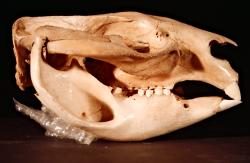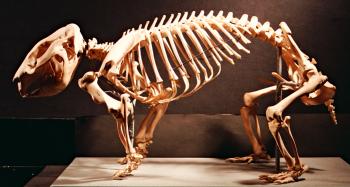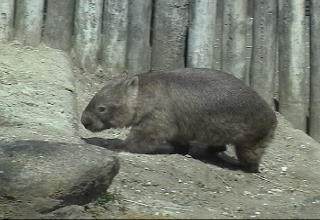
WOMBATS
SUPER COHORT MARSUPIALIA
COHORT AUSTRALIDELPHIA
ORDER DIPROTODONTIA
FAMILY VOMBATIDAE
The family Vombatidae comprises three species, the common wombat, the southern hairy nosed wombat and the endangered northern hairy nosed wombat. Wombats look very like pigs yet their closest relative is the koala. They occur in Tasmania and in some parts of Australia where they are protected species.
Wombats live in burrows ranging from 2 - 5 metres long up to extensive networks of 25 - 30 metres. They dig with their powerful front limbs, pushing loose rocks and debris away with their hind limbs. Living in arid climates, they remain in their burrows during the day to keep their temperatures down, conserve water and energy and lower their metabolic rates, but on cold days they may come out and bask in the sun. Usually slow-moving to conserve energy, they can reach speeds of 40 km per hour.
 |
Skull of Common wombat: dental formula: I1/1; C0/0; P1/1; M 4/4. |
Their diet consists of grasses, roots, sedges, bark and fungi, all of which are relatively low in protein and water. Their teeth are rootless and evergrowing to compensate for the wear caused by chewing tough fibrous grasses; they lack canines. The wombat uses its amazingly dextrous feet to pick up vegetation and place it in its mouth.
Wombats breed at any time of the year: the young are usually born between September and December. The female's pouch contains two teats but usually only one neonate is born at a time. Young wombats remain in the pouch for 6 - 9 months, after which they follow their mother around whilst she is foraging. They become independent at 12 to 18 months and sexually mature at 2 - 3 years. The males are usually only aggressive during the breeding season.
Common Wombat Vombatus ursinus
 |
 |
| Common wombats average a metre in length (photo courtesy of Womland) |
Common wombats are the largest members of the family reaching 1.2 metres in length. They live in Tasmania and New South Wales, Australia. They are short and stocky, with a stubby tail. Their thick, coarse fur varies in colour from yellow to black.
In Tasmania, common wombats occur from sea level to alpine areas but prefer heathland, coastal scrub and open forests where the soil is easier to burrow through. They make nests in their burrows out of sticks, leaves and grass. They graze for three to eight hours at night and travel long distances. Solitary animals, they use scent markings to stop their feeding areas overlapping. Wombats have no natural predators in Australia, but are hunted by the Tasmanian devil.
| Bandicoots | Dasyurids | Marsupial moles |
| Thylacine | Koala | |
| Kangaroos | Possums | Feathertail or pygmy glider |






